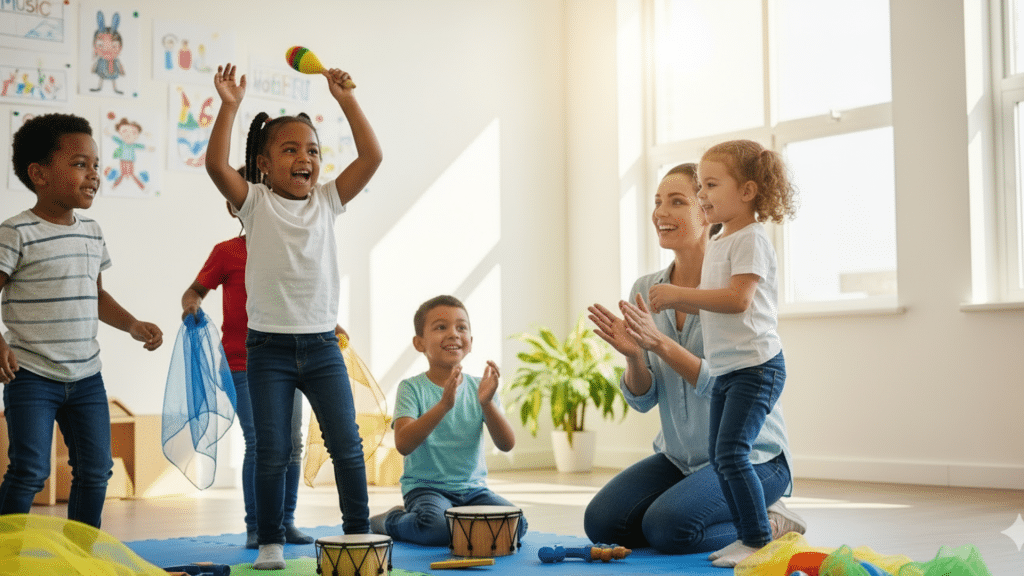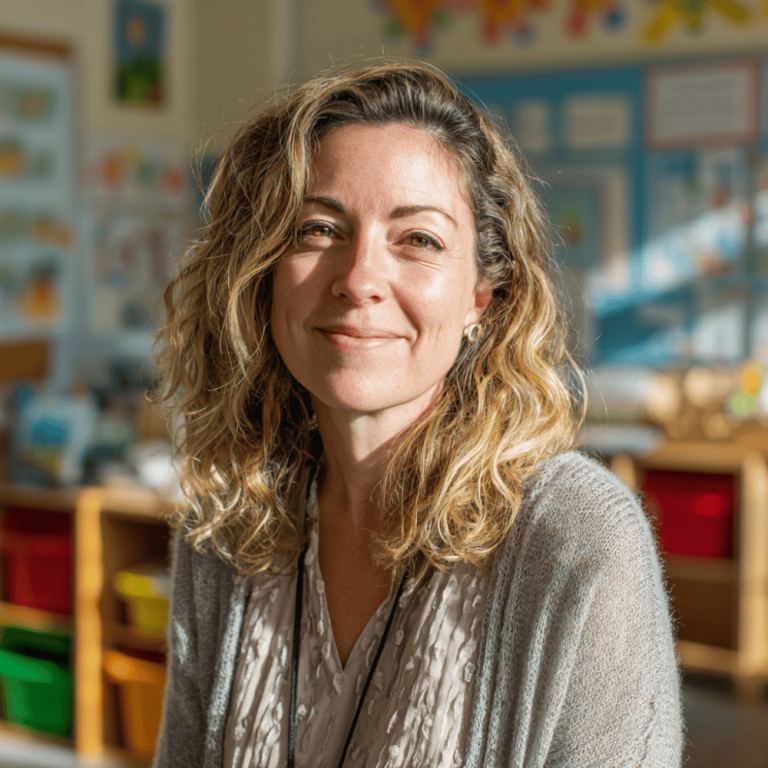Music and movement in preschool is all about mixing songs, dance, and playful actions to help children learn and grow. These activities are simple, fun, and easy for little ones to follow.
They not only get kids moving but also build important skills like coordination, memory, and social interaction.
In this guide, I’ll share both engaging videos and practical resources so you have everything in one place. You’ll learn activity ideas, understand the benefits, and find tips for teaching music and movement in early learning.
To make things even easier, the blog also includes tools and lesson planning ideas.
What is Music and Movement for Preschool?
Music and movement for preschool means using songs, rhythms, and body actions to support learning. It helps children practice skills, express themselves, and stay active. These activities can be used at school or at home.
Parents can join in by singing action songs, clapping to rhythms, or dancing in the living room. On rainy days, freeze dance, a small dance party, or a pillow obstacle course works well.
Simple, screen-free options include making shakers with rice or drumming on pots.
Key elements include:
- Singing along to familiar songs
- Dancing or moving to a beat
- Playing simple instruments like shakers or drums
- Using claps, stomps, and body actions for rhythm
Free play lets children find music on their own, while structured activities give clear steps and goals.
Benefits of Music and Movement in Early Childhood
Music and movement in early childhood support whole-child development, offering benefits for the body, mind, and emotions.
- Physical development: Builds coordination, strength, and balance through dancing, jumping, and rhythmic play.
- Cognitive growth: Improves memory, sparks creativity, and strengthens focus when children learn lyrics or follow patterns.
- Social-emotional learning: Encourages teamwork, teaches turn-taking, and builds confidence during group songs and dances.
- Emotional expression: Provides a safe outlet for children to learn and express their feelings through sound and movement.
Engaging Music and Movement Videos for Preschool
Videos are one of the easiest ways to bring music and movement into preschool. They grab attention with fun visuals and clear directions. Below are the top picks that work well at home or in the classroom:
1. Miss Nina
Miss Nina’s videos are full of energy, making them perfect for preschool circle time. Her playful songs use hand motions, claps, and big actions that kids can easily follow.
These activities are ideal for ages 3–5, encouraging participation and confidence through movement and music.
2. The Kiboomers
The Kiboomers offer a wide mix of preschool songs with clear, simple instructions. Their videos work well for everyday routines like cleanup, lining up, or starting the day.
The easy movements help kids build motor skills while keeping the classroom organized and fun.
3. Ms. Rachel
Ms. Rachel’s calm and interactive style makes her a favorite for younger children. Her videos mix language development with gentle songs and movements.
Toddlers and early preschoolers benefit from her slow pace, which helps them learn words, body parts, and basic actions in a supportive way.
4. Danny Go
Danny Go brings high energy to preschool music with exercise-inspired dance routines. His videos keep children moving with fast-paced songs and full-body actions.
They are excellent for releasing energy, building coordination, and getting kids excited about physical activity while still learning important movement skills.
5. Laurie Berkner Band
The Laurie Berkner Band creates engaging sing-along songs paired with imaginative movements. Their music encourages children to pretend, learn emotions, and move in creative ways.
These videos are loved by both parents and teachers, making them great for group fun or at-home bonding activities.
6. Super Simple Songs
Super Simple Songs are designed with clear instructions, slower tempos, and repetition. These features make them especially helpful for language development in preschoolers.
Children can sing along while practicing basic motions, which keeps learning easy and accessible for even the youngest learners in a group.
7. Jack Hartmann
Jack Hartmann’s videos combine learning with movement, teaching letters, numbers, and shapes through song. Each video pairs simple actions with educational content, helping preschoolers absorb concepts while staying active. Teachers find these videos helpful for reinforcing lessons in an engaging and movement-friendly way.
8. Patty Shukla Kids TV
Patty Shukla’s upbeat songs are perfect for both small and large groups. Her music includes actions that kids can easily follow, keeping classrooms or playdates lively.
The videos balance fun and structure, supporting gross motor development while keeping children engaged in group participation.
9. Bounce Patrol
Bounce Patrol’s colorful, animated style makes it one of the most engaging channels for preschoolers.
The videos include repetitive movements that are easy to follow, keeping children active while reinforcing learning. Their songs cover topics like colors, counting, and everyday routines in a playful way.
10. Maple Leaf Learning
Maple Leaf Learning videos combine vocabulary lessons with simple movements. They use fun animations and catchy songs that help children remember new words while moving their bodies.
Teachers often use these videos to introduce basic English skills in a fun, motion-filled classroom environment.
11. Have Fun Teaching
Have Fun Teaching creates songs that mix early education topics with movement. Preschoolers learn about colors, numbers, and days of the week while dancing or clapping along.
These videos keep learning active and interactive, giving children a way to practice lessons while enjoying music.
12. Pinkfong
Pinkfong is famous for Baby Shark, but the channel offers many more action-filled songs. Their videos feature bright visuals and catchy tunes with built-in dance moves.
Preschoolers love following along, making Pinkfong a popular choice for both fun play and structured classroom movement breaks.
13. The Learning Station
The Learning Station shares classic interactive songs like “Tony Chestnut” and “Boom Chicka Boom.” These videos get children laughing, singing, and moving together.
They are especially effective for large groups, as the repetitive actions and rhythms help kids stay focused while enjoying teamwork through music.
14. Alina Celeste
Alina Celeste offers gentle guitar-based songs that often include calming actions. Her videos are great for quieter moments in the classroom or winding down at home.
They encourage participation in a low-pressure way, making them useful for transitions, storytime, or relaxation activities.
15. Dr. Jean
Dr. Jean’s songs are loved by teachers for their educational and action-based focus. Her videos include songs for transitions, morning greetings, and skill practice.
Children can move, sing, and learn at the same time, a strong fit for daily classroom routines.
16. The Wiggles
The Wiggles are a classic children’s group known worldwide for their catchy songs and interactive dances.
Their videos combine music, storytelling, and movement, encouraging preschoolers to sing, clap, and dance along. They work well for both fun at home and structured preschool routines.
How to Teach Music and Movement Effectively
Teaching music and movement is easier when activities are simple and structured. Follow these steps to make sessions engaging and successful:
- Choose developmentally appropriate songs: Select songs that fit the age group. Use slower, simpler ones for younger children, and add more complex actions as they get older.
- Mix tempos and styles: Balance fast, active songs with slower, calming ones. This keeps children engaged while helping manage their energy levels.
- Encourage all kids to participate: Focus on enjoyment rather than perfect moves. Allow children to follow at their own pace while joining in the fun.
- Use classroom management strategies: Keep each activity short, around 5 minutes. Repeat familiar songs often, introduce new ones gradually, and give clear directions before starting.
- Show a demonstration video: A short circle time video can model how to lead songs and actions. It gives teachers and parents confidence while showing children what to expect.
Lesson Planning and Implementation
Music and movement can be part of daily routines or themed lessons. Planning ahead keeps activities consistent and easier to manage for both teachers and children.
- Daily Structure Examples: Start with a 5–10 minute warm-up during circle time. Use a familiar song to get children moving and focused before beginning the day’s lessons.
- Weekly Thematic Plans: Choose themes like seasons, animals, or holidays. Match songs and actions to the theme to keep activities fresh and connected to what children are learning.
- Printable Lesson Plan Template: Create or share a simple PDF with space for songs, props, and notes. A structured template helps teachers stay organized and consistent each week.
- Sample Lesson Video: A short video example makes it easier to see how songs, actions, and structure fit together during circle time.
Add music breaks between lessons, use songs for transitions, and include movement during storytime. Short routines work best for building lasting habits.
Tools, Props, and Resources
Having the right tools makes music and movement more fun and engaging for preschoolers. Here are some simple items and resources you can use.
| Category | What to Use | Why It Helps |
|---|---|---|
| Recommended Props | Scarves, rhythm sticks, tambourines, parachutes | Makes songs interactive and keeps children engaged through hands-on play |
| Suggested Apps & Playlists | Child-friendly apps, YouTube, Spotify playlists with movement songs | Provides quick access to music and activities designed for kids |
| Free & Paid Resources | Lesson plan PDFs, teacher guides, activity cards | Helps organize activities and introduce new learning ideas easily |
Conclusion
Music and movement play a powerful role in preschool learning. They build coordination, balance, and strength while also supporting memory, focus, and creativity.
Children gain confidence, learn teamwork, and find safe ways to express their feelings through simple songs and actions.
These benefits show how important it is to make music and movement a regular part of early education. Both educators and parents can use videos and hands-on activities to keep children engaged.
Videos provide structure and fun visuals, while simple props or instruments add variety. Starting small with a few songs each day can make a lasting difference.
Frequently Asked Questions
Do you need special training to lead music and movement?
No, basic activities can be led by any parent or teacher with songs, simple props, and patience.
At what age is it best to start music and movement?
Children can begin as toddlers with clapping, bouncing, and simple songs. By ages 3–5, preschoolers are ready for structured activities with more complex actions and rhythms.
How can music and movement support children with special needs?
Restyling activities with slower songs, repeated actions, and clear visuals can help. These support motor skills, language, and emotional regulation in children with developmental differences.











